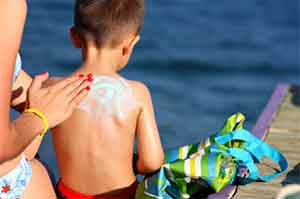Sunscreen: A Little Dab Won’t Do You
 With temperatures expected to climb fast in the coming weeks, a Rowan Medicine physician says it’s time to remember that it only takes a couple minutes to protect yourself from a disfiguring and deadly disease.
With temperatures expected to climb fast in the coming weeks, a Rowan Medicine physician says it’s time to remember that it only takes a couple minutes to protect yourself from a disfiguring and deadly disease.
“Everybody – and I mean every body – needs sunscreen,” said Dr. Jennifer Caudle a Rowan University Family Medicine physician. “Your ethnicity doesn’t matter; how easily you tan doesn’t matter. If you go out in the sun without sunscreen you are putting yourself at risk for melanoma, one of the deadliest forms of cancer.”
Dr. Caudle reminds her patients that there is no such thing as a “healthy tan,” and while melanoma rates tend to be highest among older men, there has been an alarming increase in recent years among young adults, particularly among young women. The National Cancer Institute estimates that more than 76,000 new cases of melanoma will be diagnosed in the United States this year.
“There are two possible factors involved here,” Dr. Caudle explains. “Skin cancer can take years to appear, and decades ago sunscreens simply weren’t available. In the case of some, there’s a strong suspicion that the use of tanning beds to get a ‘base tan’ before beach or prom season has exposed many teens to unsafe levels of ultraviolet light.”
While the first attempts to create a sunscreen date to the 1930s, it wasn’t until forty years later that the first Sun Protection Factor (SPF) system was developed. In 2012, the Food and Drug Administration issued new regulations that clarified labeling requirements to help consumers choose products with the right sun protection factor for themselves and their families.
SPF measures how much of the sun’s ultraviolet (UV) radiation is needed to cause sunburn on protected skin compared to the amount of UV radiation required to produce sunburn on unprotected skin. As the SPF increases, the protection against sunburn increases. This is a popular misconception because SPF does not indicate time that can be spent in the sun without getting sunburn. Rather, SPF measures the amount of protection that sunscreens provide against sunburn.
A broad spectrum sunscreen protects against both types of harmful sun rays – ultraviolet A (UVA) and ultraviolet B (UVB). Both types of rays contribute to skin cancer and can cause damage to the skin.
“And a lot of factors can affect sunscreen performance,” Dr. Caudle warned. “Swimming and sweating can wash off some sunscreens and most people don’t use enough or reapply sunscreen often enough.”
How much sunscreen should you use?
“On average about one ounce,” Dr. Caudle advises. “That may not seem like a lot, but it’s enough to cover your palm or fill a shot glass. And, even though the labels may make you think otherwise, reapply sunscreen every two hours for maximum protection because the sun’s rays vary in intensity throughout the day.”
Source Newsroom: Rowan University

